The recent staffing shortages in the U.S. aviation sector have exacerbated flight delays, coinciding with the ongoing government shutdown. As air traffic control facilities struggle to maintain adequate staffing levels, the ripple effects are being felt across the entire airline industry. The shutdown has led to a freeze on hiring and training new personnel, further complicating the situation. With fewer controllers on duty, the already congested airspace becomes even more challenging to navigate, resulting in increased wait times for takeoffs and landings. Airlines are facing mounting pressure to adjust their schedules, leading to a frustrating experience for travelers who depend on timely flights.
Airlines have been forced to make difficult decisions in response to these delays, often leading to cancellations and significant alterations to flight itineraries. Passengers are left stranded at airports, grappling with the uncertainty of when they might reach their destinations. The combination of staffing shortages and the government shutdown has created a perfect storm, where operational inefficiencies have become the norm. This situation raises concerns about the long-term viability of the aviation industry, as customer satisfaction wanes in the face of repeated disruptions.
Moreover, frequent delays and cancellations can have a cascading effect on the economy as a whole, impacting not just airlines but also hotels, rental car companies, and other sectors reliant on air travel. As business travelers miss crucial meetings and vacationers find their plans derailed, the economic repercussions are likely to ripple through various industries. The federal government plays a critical role in ensuring the smooth operation of air travel, and the current shutdown highlights the vulnerabilities in the system. Stakeholders from across the aviation sector are calling for a resolution to the impasse, emphasizing the need for a stable and reliable air transportation system.
In the face of these challenges, it is imperative for both the government and industry leaders to collaborate on solutions that will not only address the immediate staffing shortages but also establish a long-term strategy for workforce sustainability. Enhanced recruitment efforts, improved working conditions for air traffic controllers, and streamlined training processes could help mitigate the impact of future disruptions. As the situation unfolds, the aviation industry must adapt to these challenges while prioritizing the needs of travelers, ensuring that the skies remain open and accessible for all.




